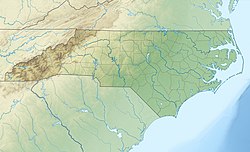Raleigh | |
|---|---|
|
| |
| Nickname(s): | |
| Motto(s): Amore et Virtute (Latin for "by Love and Virtue") | |
 Interactive map of Raleigh | |
| Coordinates: 35°51′15″N 78°45′43″W / 35.85417°N 78.76194°W | |
| Country | United States |
| State | North Carolina |
| Counties | Wake, Durham |
| Chartered | December 31, 1794 |
| Named for | Sir Walter Raleigh |
| Government | |
| • Type | Council–manager |
| • Body | Raleigh City Council |
| • Mayor | Mary-Ann Baldwin (D) |
| • Council | |
| Area | |
| • Total | 149.60 sq mi (387.50 km2) |
| • Land | 148.54 sq mi (384.73 km2) |
| • Water | 1.07 sq mi (2.77 km2) 0.72% |
| Elevation | 331 ft (101 m) |
| Population (2020) | |
| • Total | 467,665 |
| • Estimate (2023) | 482,295 |
| • Rank | 41st in the United States 2nd in North Carolina |
| • Density | 3,148.33/sq mi (1,215.57/km2) |
| • Urban | 1,106,646 (US: 43rd) |
| • Urban density | 1,994.6/sq mi (770.1/km2) |
| • Metro | 1,509,231 (US: 41st) |
| Demonym | Raleighite |
| Time zone | UTC−5 (EST) |
| • Summer (DST) | UTC−4 (EDT) |
| ZIP Codes | 276XX |
| Area code(s) | 919, 984 |
| FIPS code | 37-55000[7] |
| GNIS feature ID | 2404590[5] |
| Website | raleighnc |
Raleigh (/ˈrɔːli/ RAW-lee)[8] is the capital city of the U.S. state of North Carolina and the seat of Wake County. It is the second-most populous city in North Carolina, after Charlotte. Raleigh is the tenth-most populous city in the Southeast, the 41st-most populous city in the U.S., and the largest city of the Research Triangle metro area. Raleigh is known as the "City of Oaks" for its many oak trees, which line the streets in the heart of the city.[9] The city covers a land area of 148.54 square miles (384.7 km2).[4] The U.S. Census Bureau counted the city's population as 467,665 at the 2020 census.[10] It is one of the fastest-growing cities in the United States.[11][12] It is ranked as a sufficiency-level world city by the Globalization and World Cities Research Network.[13] The city of Raleigh is named after Sir Walter Raleigh, who established the now-lost Roanoke Colony in present-day Dare County.
Raleigh is home to North Carolina State University (NC State or NCSU) and is part of the Research Triangle together with Durham (home of Duke University and North Carolina Central University) and Chapel Hill (home of the University of North Carolina at Chapel Hill). The name of the Research Triangle (often shortened to "The Triangle") originated after the 1959 creation of Research Triangle Park (RTP), located in Durham and Wake counties, among the three cities and universities. The Triangle encompasses the Raleigh-Durham-Cary, NC Combined Statistical Area, which had an estimated population of 2,368,947 in 2023. The Raleigh-Cary, NC Metropolitan Statistical Area had an estimated population of 1,509,231 in 2023.[6]
Most of Raleigh is located within Wake County, with a small portion extending into Durham County.[14] The towns of Apex, Cary, Clayton, Fuquay-Varina, Garner, Holly Springs, Knightdale, Morrisville, Rolesville, Wake Forest, Wendell, and Zebulon are some of Raleigh's primary nearby suburbs and satellite towns.
Raleigh is an early example in the United States of a planned city.[15] Following the American Revolutionary War when the U.S. gained independence, the area was chosen as the site of the state capital in 1788 and incorporated in 1792 as such. The city was originally laid out in a grid pattern with the North Carolina State Capitol at the center, in Union Square. During the American Civil War, the city was spared from any significant battle. It fell to the Union in the closing days of the war and struggled with the economic hardships in the postwar period, related to the reconstitution of labor markets, over-reliance on agriculture, and the social unrest of the Reconstruction Era. The establishment of the Research Triangle Park (RTP) in 1959 helped create tens of thousands of jobs in the fields of science and technology. By the early 21st century, Raleigh had become one of the fastest-growing cities in the United States.
- ^ Delongowski, Carly (January 21, 2021). "Why is Raleigh nicknamed the City of Oaks?". RAL Today. Retrieved November 26, 2022.
- ^ Wells Shannon, Mary (August 26, 2022). "The Best Nicknames for Southern Cities". Southern Living. Retrieved November 26, 2022.
- ^ "City Council: Raleigh's Governing Body". City of Raleigh. May 6, 2016. Archived from the original on May 6, 2016. Retrieved May 9, 2016.
- ^ a b "ArcGIS REST Services Directory". United States Census Bureau. Retrieved September 20, 2022.
- ^ a b U.S. Geological Survey Geographic Names Information System: Raleigh, North Carolina
- ^ a b "Metropolitan and Micropolitan Statistical Areas Population Totals: 2020-2023". United States Census Bureau, Population Division. March 14, 2024. Retrieved March 15, 2024.
- ^ "U.S. Census website". United States Census Bureau. Retrieved January 31, 2008.
- ^ Wells, John C. (2008). Longman Pronunciation Dictionary (3rd ed.). Longman. ISBN 978-1-4058-8118-0.
- ^ "Population & Census Information". City of Raleigh. Archived from the original on July 21, 2009. Retrieved August 21, 2009.
- ^ "QuickFacts: Raleigh city, North Carolina". United States Census Bureau. Retrieved May 16, 2024.
- ^ "Cary third fastest growing city in '08; Raleigh is 8th, Durham 16th". wral.com. July 1, 2009. Retrieved July 2, 2009.
- ^ Fisher, Daniel. "America's Fastest-Growing Cities". Forbes.com. Retrieved May 14, 2012.
- ^ "GaWC – The World According to GaWC 2020". www.lboro.ac.uk. Retrieved July 21, 2024.
- ^ "Raleigh Durham Annexation Agreement Lines" (PDF). City of Raleigh. Archived from the original (PDF) on October 19, 2011. Retrieved January 4, 2012.
- ^ Cite error: The named reference
RaleighNCHPwas invoked but never defined (see the help page).












